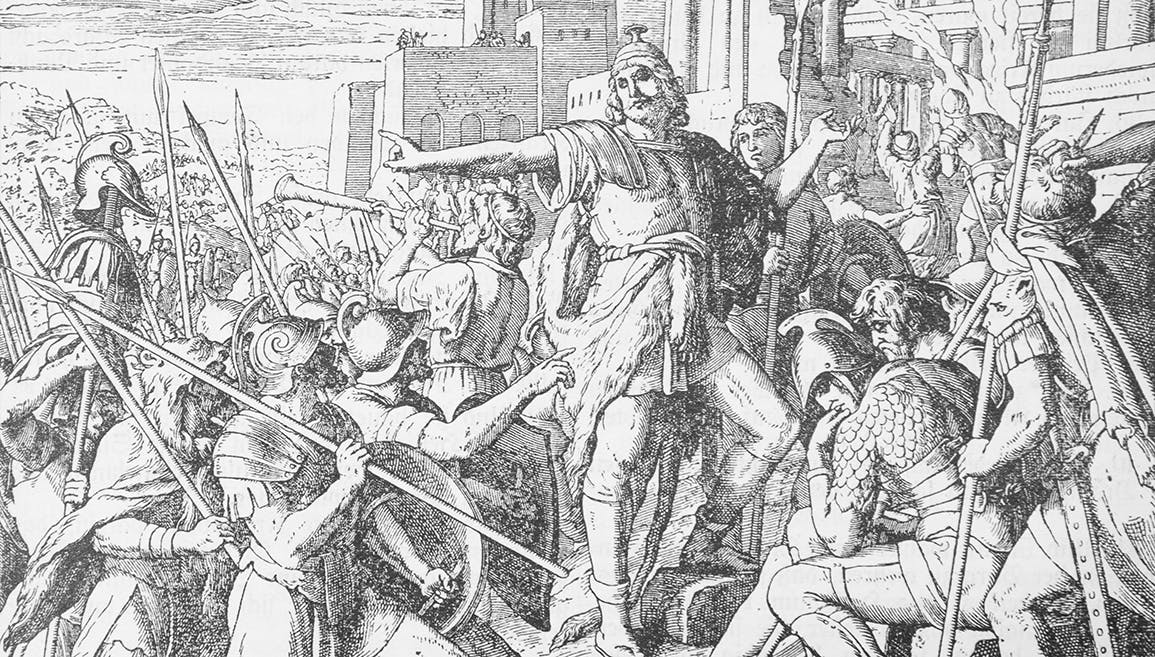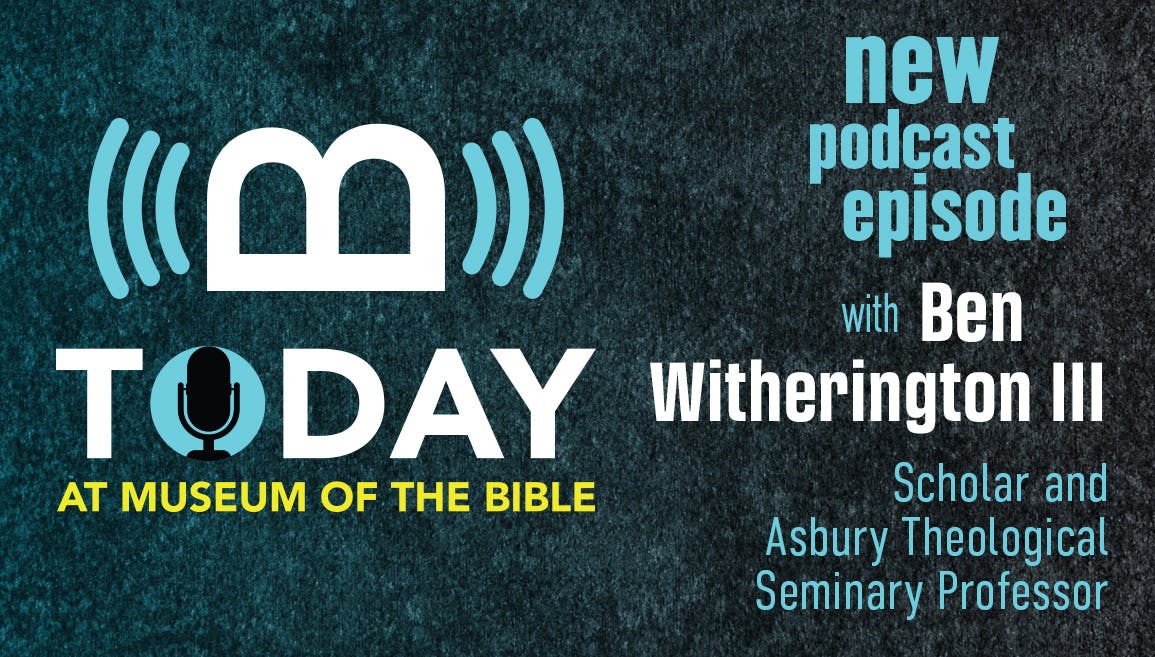Unpacking Myths about Religion and Science with Dr. Ted Davis

Recently on our podcast, Today at Museum of the Bible, Charlotte Clay, our director of Marketing and Communications, interviewed historian of science Dr. Ted Davis. This discussion provides a look into some of the misconceptions around religion and science as well as a sneak peek into our latest exhibition, Scripture and Science: Our Universe, Ourselves, Our Place.
The following interview has been edited for clarity and space. To listen to the whole interview, check it out here on our podcast.
Charlotte Clay: Welcome to Today at Museum of the Bible. I'm Charlotte Clay, and I'm here today with Dr. Ted Davis, historian of science and professor emeritus at Messiah University. Welcome, Ted. Thank you so much for being on the show.
Ted Davis: I'm delighted to be here.
Charlotte: Ted, you've advised the Smithsonian and been a key part of the advisory panel for Scripture and Science. What made you want to study the history of science and focus on faith and science?
Ted: The short version would be that when I graduated from high school, I knew for sure three things. First, I wanted to be an astrophysicist. Second, I hated the humanities. And third, I would never teach. It's funny I ended up being a humanities professor and not an astrophysicist. In between those two endpoints, a lot went down, including a developing interest in the history of science and the history of ideas. My number one interest became ideas in culture. With that came a developing interest in the history of science and Christian faith because my first real job was as a high school science and math teacher at a Christian school in Philadelphia. I got introduced to a really important organization of Christians in the sciences called the American Scientific Affiliation. That's what really helped me develop my interest in science and faith. I decided to do work in the history of science in graduate school.
Charlotte: How have religion and science intersected historically? And do you think they're destined for perpetual conflict?
Ted: Well, let me pick up with the perpetual conflict. This whole notion of a perpetual conflict is completely rejected by historians of science. It's not just those of us that have faith, secular historians of science do not believe in a perpetual conflict between science and religion historically. That's been debunked in professional circles.
Charlotte: You've written about famous myths in the history of faith in science. I'd love to hear you talk about the flat Earth myth.
Ted: Well, this might be the most common myth about the history of science and religion. In the late twentieth century, middle school textbooks talked about how Columbus had to persuade Queen Isabella and the religious and academic authorities in Spain that the earth actually is round and it was feasible for him to sail to Japan and the Indies by going west across the Atlantic Ocean. Nothing like this ever went down involving Columbus and Isabella. In fact, every university-educated European of Columbus's day had been taught that the earth is round because the universities had required courses in astronomy. And the standard textbook used opened with a discussion of the Earth's shape as a sphere and even approximately how big it is. That information had been known since before the time of Christ. The Greeks, by fourth century BC, knew Earth is round and had rough ideas on how round. And by about 250 BC they knew, with real precision, how far around the Earth is. In the best case, they were within 1% of the modern value. And that knowledge never disappeared in all the countries that take their history of ideas from the Mediterranean world. So that would include Jews, Christians, Muslims.
Charlotte: I understand as part of the Scripture and Science exhibit, there is going to be an artifact people can view that tells us a lot more about this. Can you share a little bit about that?
Ted: There is the textbook that was used at these universities written by an English monk named John of Sacrobosco, a professor of mathematics. Mathematics professors often taught astronomy because it's a mathematical science. He was a professor at the University of Paris, one of the oldest and leading universities and also has the greatest school of theology. This was in the mid-1200s and that book stayed around until the mid-1600s. One of the manuscripts the exhibit will feature is a Hebrew translation of Sacrobosco. An interesting feature about Sacrobosco, the end of his book, in most Latin versions and in all the printed versions I've consulted from the fifteenth and sixteenth centuries, ends with the darkness at noon at the crucifixion. Sacrobosco says this can't have an ordinary astronomical explanation—it's got to be a miracle. I understand that the manuscript coming here from the National Library of Austria in Vienna, this Jewish manuscript does not include that part of Sacrobosco. A few of the Latin manuscript versions don't include that, although, as I understand it, the large majority do. So, it's probably authentic in the original, which would have been handwritten. And those kinds of things tend to change a lot when they get copied. The printing revolution in the fifteenth century was enormously influential on the development of ideas and on science, too, because you have fixed texts of ideas that now you can explore and debate.
Charlotte: Can you speak to whether the medieval church hindered the growth of science in the Middle Ages?
Ted: Well, one reason this myth is so popular is because a scientist who probably was known by literally at least a billion people fifty years ago put this in a book about the history of science. A book that is an ideologically loaded book about science being the candle in the darkness—and the darkness includes traditional religion. Science, for Carl Sagan, the Cornell astronomer, was a candle in the darkness. He became so famous worldwide because of a PBS film series he did called Cosmos. Sagan promotes an idea known as the “medieval gap.” For Sagan, that gap of a thousand years, more or less, is the time when the Catholic Church was dominant in Europe. He makes implicit connections—and sometimes explicit—about the role of the medieval church in holding back the progress of thought. And you find ridiculous versions of this in some popular literature today. Claim, for example, that if the church hadn't been in charge of intellectual life in Europe, people would have discovered the cure for cancer by the year 800, and they'd have had people in space by 1000. Sagan, who wasn't a trained historian, wrote a lot about the history of science and other ideas in his book and talked about them a lot in his film series. This is where people get their history. He was simply perpetuating myths, but they become known worldwide because Sagan had such an international reputation. As for the medieval church, it was described by a recent scholar, who is Jewish, as the leading supporter of science in the Middle Ages. He was right. Almost all the scholars who were doing science in the Middle Ages were either theologians or clergy, or they were teaching at universities, many of which had been started by church authorities.
Charlotte: Continuing our myth busting, is it true Copernicus demoted humans from the center of the cosmos?
Ted: This is another common myth, perpetrated by many modern astronomers, among them Carl Sagan, the idea that we are insignificant specks in the universe. The demotion idea involves this: In the ancient world, almost everyone, including almost every scientist, knew that the Earth is at rest in the center of the universe.
So when Copernicus suggests the Earth is going around the sun, the idea is not only crazy to most people, it also takes us out of the center of the cosmos and makes us into the third planet around the sun. Does that demote us? Only if you believe the center is a good place. But they didn't. The good place was in the heavens. People didn't believe Earth was a special place at all. They thought the heavens were a special place. And indeed, in Aristotelian theory, his ideas teach that the Earth is a base place. Dante is the medieval Italian poet who writes the story about the cosmos called the Divine Comedy. And the paradise section is all about the heavens. And for Dante, hell is below the Earth's surface in the center, and there are various layers. And this is where the worst of all the tortures are put upon people, in the very center of the universe. So, the center of the universe is a bad place to be in medieval thought. If Copernicus moved us out of the center into the heavens, how can he possibly be thought as demoting humanity?
Charlotte: You've written and studied extensively about Robert Boyle, a pioneer of modern chemistry and the modern experimental scientific method, and you've written about his piety and his struggle over his entire life with religious doubt. How did his faith and his doubt shape the ways he conducted his scientific life?
Ted: Boyle, before he became a scientist or natural philosopher, was a deep thinker theologically, religiously. He was a devout Christian, having been converted in a thunderstorm and having fears of the final judgment coming in his head. And he vowed to live piously ever after. When he was about 20 years old, in one of his diaries that still survives today, he wrote this: “He whose faith never doubted may justly doubt of his faith.” This is because he himself had doubts from his teenage years on. And when he would have these doubts, which seemed to have nagged him his whole life, he would then go into deep thought, reflect on his faith. So he wrote a tremendous amount of literature, both published in his lifetime or afterward or still unpublished today. He was, in some ways, one of the first important apologists from Christian history. And the difference he makes was he would bring science into it. Traditionally, apologetics didn't involve science. It involved literary studies. It involved defenses of the truth of the Bible and things of this type. But Boyle, as a pioneer of the new science, brought these new ideas of science into his conversation with imagined atheist opponents. And he wanted to use science to help persuade these people that God is real. He wants to move people to piety and thinks science can help do this by persuading people it's crazy to think the world was not created.
Charlotte: Fascinating. I'd love to hear what you want people to take away from your work.
Ted: I hope they would find my work reliable, accurate history, regardless of what they think of it, in terms of if it means anything beyond that. But we really do need accurate histories of Christianity and science. I want to contribute pieces and try to get us closer to an accurate history of Christianity and science, warts and all. For so many years, we were given these false histories of science and faith that were ideologically motivated, whereas I'm interested in the truth. I think we can learn a lot of the truth, and we want to tell the truth about the history of science and faith.
Charlotte: Well, thank you so much, Ted. And we're looking forward to having you back at the museum very soon.
To learn more about the history of the Bible and science, come see our newest exhibition, Scripture and Science: Our Universe, Ourselves, Our Place. The exhibit is open till January 15, 2024, and is included with a general admission ticket. You can learn more here.


